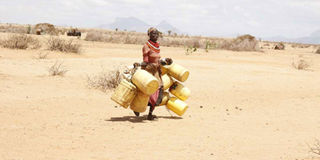Agency on the spot as water shortage bites despite rains

A resident of Nahagan Manyatta in Korr, Marsabit County, on her way to fetch water. Thousands of livestock in Marsabit died at the onset of the long rains in October. PHOTO | FILE | NATION MEDIA GROUP
Ali Guyo, a Marsabit resident, lost at least 100 goats during floods, a few days after the rain began in October.
He estimated he lost at least Sh500,000 in just one day. “There was drought for many years and then all of a sudden it rained and my goats were carried away by the water,” said the Maikona resident during an interview.
“It wasn’t like this in the past. Nowadays, floods are sudden and sometimes when it rains elsewhere, the water carries our livestock to the Chalbi desert,” he said.
Thousands of livestock in Marsabit died at the onset of the long rains in October. Some were carried downstream by flood waters while others died due to hypothermia. According to Mr Roba Adola, the Walda Climate Adaptation project chairman in Marsabit, around 1,600 cattle died immediately after the rains started.
When the rains finally stop and the floods recede, another problem awaits him. His remaining herd of 200 goats may die because of drought. “I do not farm. Goats are my only source of income,” he said.
Guyo is among millions of pastoralists across the country who are at the mercy of the unpredictable extreme weather conditions and to whom drought and rain may mean the same thing — losses.
Despite the changed weather, most Kenyans are dependent on rain-fed agriculture, livestock and pastoralism, making the population more vulnerable to climate shocks and, most of the time, food insecure. “A lot of that water is going to waste because there is no water harvesting,” said Elvis Lumbasio the country director of Wethungerhilfe Kenya during the recent Zero Hunger walk in Nairobi. “If only as a country we can have systems to harvest water that can be used later to irrigate and get food crops, to help fight hunger in Kenya.”
DISAGREED WITH CONTRACTORS
The concerns about poor water storage shine a spotlight on the National Water Harvesting and Storage Authority. The agency was established in 2016 with an aim of launching national public works for water storage and flood control.
It is also mandated with undertaking strategic emergency drought mitigation. “Our work is to harvest and store flood waters to be used during the dry season,” said acting chief executive officer Sammy Mburu during an interview with HealthyNation.
Already, the ongoing rain has caused havoc especially in arid and semi-arid areas of Marsabit, Wajir, Mandera and Tana River and people like Guyo are yet to feel the effects of the authority.
The nearest dam to him, believed to be the solution to flooding in the county and maybe help Guyo keep more herds of goats, is yet to be completed. The construction of Badassa dam was stopped at 52 per cent completion because of disagreements with the contractor.
“We are all aware of the dubious cycle of flooding like in the current situation, then prolonged drought season which results in the loss of lives and property in both the occasions,” said Mburu.
He said flooding can permanently be controlled through large dams and check dams. Currently, there are 13 large dams under construction in flood prone areas.
Mburu denied claims the works at Muruny (Siyoi) Dam in West Pokot stopped in April over delayed payments. Also under construction is the Umaa Dam in Kitui, which is 50 per cent complete and which recently received Sh500 million to jump-start construction, Bosto Dam in Bomet (design is ready) and Soin-Koru at the border of Kericho and Kisumu.
He said the agency is overseeing construction of small dams and water pans in at least 28 counties, which will not only help to control flooding, but will also be used by Kenyans for domestic and agricultural purposes.
In the 2018/19 financial year, the agency received Sh1.5 billion while in 2019/20, it received Sh3.5 billion which Mburu said was not enough. “We are experiencing budgetary constraints and we may not address all the projects at once. Everybody needs to do their bit, people need to construct ponds and harvest water from roof catchments,” he said.


